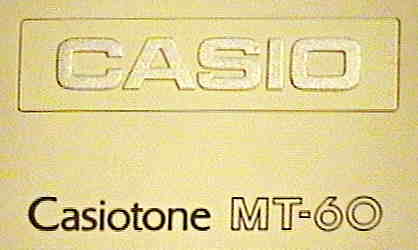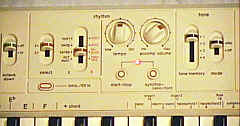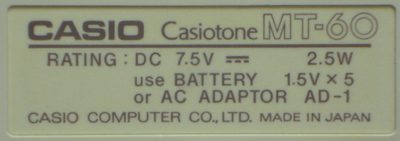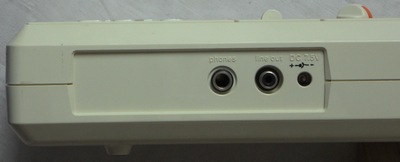 |
stairwave keyboard with unusual sound & arpeggio accompaniment |
|
This egg white Casio keyboard from 1982 has unusual, partly incredible dry stairwave sounds and a bizarre and thin sounding accompaniment with analogue drums and arpeggio. It sounds really quite weird, but that makes it unique and I like it.
Despite this instrument has the same control panel layout and case like Casio MT-45, it contains totally different hardware with a lot of discrete components. The sound selection method corresponds to the ancient Casiotone 202.
 |

The dual colour button style resembles somewhat Yamaha PS-30 of the same era. |
 |
 |
 |
The main voice soundchip D990G was likely a predecessor of the D931C (which is used in the CT-410V). Like in CT-410V, the main voice sounds of the MT-60 consist of 2 mixed digital suboscillators with different stair shaped waveforms and different digital volume envelopes, those are (depending on the preset) muffled by different filter capacitors. Thus both instruments have the same kind of sounds, although unlike the rather dull CT-410V, most (not all) sounds of the MT-60 have a very bright and partly incredible dry timbre, and when a key is trilled with sustain, each new note here occupies a new sound channel, which produces a great phasing sound and volume increase effect although this eats up polyphony. In the bass range many sounds turn into a more or less buzzy, sonorous purring drone, which is a characteristic style element of squarewave based instruments. These basses can resemble some of the famous POKEY sound effects on Atari XL homecomputers and are very different from the gradually duller and duller growing sine wave bass behaviour of average Yamaha FM keyboard sounds. (For further technical details about this hardware family also see here.)
On MT-60 the trumpet and mandolin sound more realistic than on CT-410V, and also the sonorous organ and wind instruments are nice, but best are harsh stuff like the harpsichords, and particularly the bright effect sounds are great. When sustain is switched off, all sounds stop almost immediately after releasing the key, and the sound presets itself also contain neither vibrato nor tremolo. The "funny" preset is a sort of rough digital slap bass (creaky picked e-bass) which sounds like "ennng!" (possibly it was initially intended to be called "funky", but sounded to artificial for this?). An even harsher variant of this is called "frog" (although it doesn't sound at all like one), which makes a wonderful rough and incredible dry bass noise. The "cosmic tone" preset is a slowly duller fading spacey synth pad timbre, which begins thin and quiet, and then grows louder while it makes audible use of the crossfading between the 2 subvoices. (On CT-410V it sounds simply like a plain saxophone tone, so far no envelope switches are added.) The "synth brass" is a sort- of trumpet sound which fades quieter and then louder again (sounds nice with sustain and trilled notes). The "funny fuzz" is a sort of picked string, which rapidly fades higher between 2 tones those are 4 notes apart. The "music box" rings at a slow speed of about 1Hz, which creates interesting repeating patterns when multiple keys are held down. ("Chime" is a brighter and not ringing version of it, which sounds like a cute plain squarewave toy.) There is also a ringing mandolin, which rings at a different speed and has a far less buzzy bass than on CT-410V.
To select sound presets, the "mode" switch has to be moved from "play" to "set", which will also assign the selected sound to the current position of the "tone memory" switch. The decaying sounds (e.g. piano) are selected by pressing any of the white keys, while continuous tones (e.g. organs) are selected by black keys. Very interesting is that the selected sound is played as a hint during the selection key press, but only when the key is held down longer than about 0.2s. (It's a pity that this trick is not used on average toy keyboards, because the delay would make it possible to rapidly select OBS sounds during live performance without hearing the selected sound, and despite easily test the sounds by pressing the buttons slightly longer.) When the "mode" switch is set back to "play", the keyboard behaves normal again (and the "tone memory" switch can select between 4 of these sound presets during play.)
The accompaniment is similar flexible playable like the Testron
one, and thus also accepts any disharmonic note combinations and not just
those few ones that establishment has defined to be "chords". Unfortunately
the chord timbres are very thin and creaky, and this instrument can play
only either chords or a monophonic arpeggio. The bass is dull and resembles
a triangular wave organ tone with release envelope. With rhythm off, the
rhythm slider switches the chord between 3 different and thin sounding
organ timbres. Very unusual is that when in fingered or single finger chord
mode arpeggio is enabled without rhythm, then the chord section plays instead
of bass and chord
only the arpeggio (monophonic using the chord
timbre). I never found yet any other old keyboard that can play arpeggio
without starting a rhythm, but
Casio should have at least enabled
also the bass, because the thin monophonic arpeggio without anything else
sounds so naked - really bizarre - almost absurd, but at least it is great
for new age music. (With chord memory off, the arpeggio pattern stops when
releasing the chord keys, and without rhythm it always restarts from beginning
after pressing a chord key again.) Generally this creaky accompaniment
with the trashy, old fashioned white noise home organ drums and tooting
bass always sounds a little broken, but this gives the thing also much
personality - I love this strange tablehooter. I only miss independent
volume control knobs for the individual accompaniment voices.
circuit bending detailsThe Casio MT-60 is built around the main voice CPU "NEC D990G" and accompaniment CPU "NEC D910G 012".The complex analogue hardware resembles Casio CT-410V (besides that it has no VCA). Like there the sound generation is divided into an accompaniment CPU and separate main voice sound IC, but in MT-60 not only the accompaniment CPU but also the main voice sound IC both poll the keyboard matrix (see Casiotone 401 hardware). Unlike there so the polyphony is not reduced by accompaniment.
The main voice CPU D990G is a late member of the D77xG family and so supports its generic keyboard matrix. It switches the fixed filter through pin 44, 46, 47. The accompaniment CPU "D910G 012" is a variant of the Casio VL-5 sound IC; it has the keyboard matrix inputs at the top left and most keyboard matrix outputs at the top right. Between both are some drum trigger outputs. At the bottom it has various accompaniment sound outputs. The keyboard matrix input pin seem to be {66, 63, 60, 59, 58, 57, 56, 55}. Matrix output pins are at {49, 48, 47, 46, 44, 41, 39, 75}. (I didn't fully understand the keyboard matrix yet; e.g. I didn't find the lowest bass key input, nor eastereggs.) My pin numbering was likely different from the actual IC pins. This list of lowpass filter settings for the main voice preset sounds
is found in the Casiotone 403 service manual.
Each CPU output controls through a transistor a 4066 switch. IO-5 enables filtered output. IO-6 enables plain (unfiltered) output (thus both lo would mute main voice, which may be pop protection). IO-7 and IO-8 change filter capacitors. The MT-60 doesn't use IO-6, which is likely no problem since in normal operation it is only inverted IO-5. shitshotI didn't upgrade this instrument (yet...), but I have discovered that connecting pin 76 of the D910G with various keyboard matrix outputs or pin 75 results in very strange, often disharmonic accompaniment timbres and bizarre analogue drum noises. Apparently pin 76 was intended as a serial input to be controlled by an external CPU for generating different accompaniments. Pin 75 seems to synchronize the D910G with the main voice soundchip D990G and likely also controls rhythm tempo. |
Despite the case shape and button layout of the MT-60 is identical with Casio MT-45, the latter contains a simpler PCB with totally different hardware, which features only 8 main voice sounds but a very sonorous and powerful droning accompaniment - the contrast between these unequal twins could not be bigger.
A fullsize cross between MT-60 and Casiotone
401 (Casio's first keyboard with rhythm and accompaniment,
which had 16 semi- OBS preset rhythms) was the large Casiotone 403,
which had a noble looking brown wood case with the same preset sound names
like MT-60 written above the keys, but rhythm button section like 401;
it likely also had full polyphonic chords, because like 401 it contains
a "TI TMS3615-25NS" tone generator IC and "D8049" CPU (seen on internet
photos and service manual). A cheaper 403 variant without rhythm/
accompaniment was released as Casiotone 101 (aka CT-101).
| removal of these screws voids warranty... | ||
 |
||
|
|